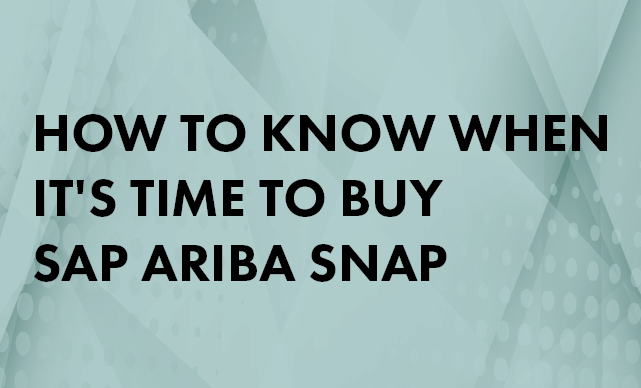Procurement’s Top 10 Transformation Initiatives in 2025 & How SAP Helps – Part 1
Meet the Authors
Key Takeaways
In 2025, procurement teams will prioritize transformation initiatives such as data analytics and talent management to close productivity and efficiency gaps, which are estimated at 8.8% and 8.9%, respectively.
AI and automation are essential for enhancing decision-making in procurement; solutions like SAP's Spend Control Tower and Ariba Category Management will be vital in optimizing sourcing, spend visibility, and procurement efficiency.
Effective supplier relationship management and talent development will be crucial, with tools available for managing supplier lifecycles and flexible workforce needs, emphasizing the importance of strategic sourcing and category management.
2025 may be a time for procurement to rethink and merge its myriad technology offerings. The advent of AI and new ways to connect, integrate, and automate gives the function a quick and cost-efficient way forward.
Procurement’s Focus in 2025
According to The Hackett Group’s 2025 Procurement Agenda and Key Issues Study, the most popular planned transformation initiatives for procurement teams in 2025 include data analytics and talent management. The study shows a productivity gap of 8.8% coupled with an efficiency gap of 8.9%, and technology spending could grow by an estimated 5.6% to close these gaps.
Top 10 Transformation Initiatives of 2025
In the first part of this series, we look at five of the top 10 improvements the procurement function is preparing to make this year, according to The Hackett Group study, and ways SAP can help.
Explore related questions
1. Data analytics and reporting
Reporting tells you what happened, but you need aggregation and insights to determine what to do next. And you need it all delivered in a way that’s intuitive for everyone on your team. In addition, clean data is key to being able to take advantage of anything AI.
With the SAP Spend Control Tower, organizations can see all their spending in one place by aggregating and consolidating data from their systems, business units, ERPs, and countries. Additionally, this solution helps organizations understand their cost drivers and maintain good visibility of spending as the organization changes while gaining market intelligence.
2. Talent management
The Hackett Group Report shows that the skill set needed in procurement is changing as teams use more technology, and the business demands more cost savings and other efficiencies. It adds that more acumen around analysis and strategic thinking is required.
Solutions such as SAP Ariba Category Management and SAP Ariba Buying offer internal procurement teams the ability to upskill as the software offers step-by-step instructions on how to develop category management goals, pulling in outside intelligence to finite. Talent on demand may be an option for companies SAP Fieldglass Contingent Workforce Management gives you the ability to manage contingent workers via an VMS.
3. Category management
Now is the time for organizations to seek rebalancing inventory security while freeing up more working capital they’ve amassed due to excess inventory. Introducing automation and intelligence into spend management is also crucial.
SAP Ariba’s Category Management solution equips category managers with AI that can streamline these tasks, help in external market profiling, and deliver recommendations and insights into categories and opportunities. In addition, the SAP Ariba Spend Control Tower solution harnesses cutting-edge spend analysis to drive better decision-making, while its Buying and Invoicing solution helps automate the entire purchasing lifecycle, unifying the search for indirect goods and services.
4. Strategic sourcing
Strategic sourcing is clearly in focus as procurement teams double down on service design and delivery projects in 2025. Organizations’ technological maturity in this aspect is also higher this year.
By utilizing the SAP Ariba Strategic Sourcing Suite, organizations can speed up time to market and gain a competitive advantage. Process manufacturers, retailers, and discrete manufacturers that rely on external manufacturers can save costs through this solution by improving source-to-contract processes and supplier collaboration with a sourcing suite that supports industry-specific processes and systems.
5. Supplier relationship management (SRM)
According to the report, procurement functions’ technological maturity for SRM is relatively high, as this aspect remains critical for organizations. Procurement teams are exploring innovative approaches to better manage supplier lifecycles, performance, and risk within their source-to-pay process.
Supplier Management within SAP Ariba Spend solutions allow organizations to manage lifecycle, performance, and risk in one place to get the right products from the right suppliers at the right time. It helps procurement drive spending to preferred suppliers, integrate supplier management with procurement, manage with a unified supplier record, and scale risk management across the supply base.
What This Means for SAPinsiders
AI-driven procurement transformation is gaining momentum. With AI and automation becoming central to procurement, SAP users can leverage SAP Ariba Category Management and SAP Ariba Spend Control Tower to enhance decision-making and streamline category management. AI-driven insights will help optimize sourcing, spend visibility, and procurement efficiency.
Enhanced data analytics lead to smarter decision-making. Clean and consolidated data is essential for procurement success. SAP Spend Control Tower empowers users by aggregating spend data from multiple sources, providing a unified view of costs and enabling strategic cost management, all critical for AI adoption and better decision-making.
Strategic supplier and workforce management is a must. As procurement focuses on supplier relationship management and talent development, SAP Ariba Supplier Management helps organizations manage supplier lifecycles, risk, and performance, while SAP Fieldglass Contingent Workforce Management supports the growing need for flexible, on-demand talent.






